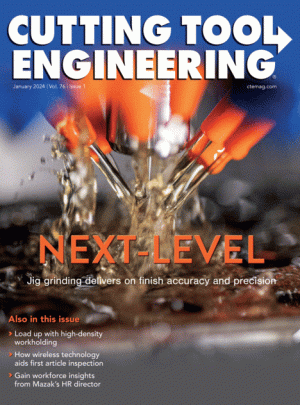Wireless devices were almost non-existent in the ‘80s when I grew up. Other than a TV remote and the wireless home phone, all electronic devices were wired. Obviously, we are a long way from those days with cell phones, Bluetooth and cars that are connected to the web. Wireless devices now dominate the electronics market, and every imaginable device now offers users connectivity options.
Industrial tools and equipment are experiencing the same advances. As we have entered the fourth industrial revolution, dubbed the Industrial Internet of Things, new technologies have entered the market and there are new career paths for people who can implement these new technologies. Today, machinists, tool makers and engineers want tools that have modern features like those found on cell phones and tablets. Manufacturers have responded to the demand by introducing a myriad of tools that can connect and interact with mobile devices and computers. Metrology tools are some of the best examples.
First article inspection (FAI) is a necessary evil in modern shops that strive for world class quality. FAI, as the name implies, is a very thorough check of the first part to ensure that the setup is good and that subsequent parts will be dimensionally correct. Performing FAI requires the machinist or quality inspector to measure and record a lot of dimensions, which can be a tedious job.

Complex parts can take a long time to process through FAI, and that can lead to delays in production and force a machine tool to sit idle for hours. What’s more, having to measure and record a large volume of measurements is not only time consuming, it also provides many opportunities for error. Automating the data collection is the surest way to reduce measurement time and eliminate recording errors.
Gauges with wired communication capabilities have been used for automated measurement for a couple of decades. However, wired connections can be cumbersome, and are not compatible with mobile devices like tablets and cell phones. Fortunately, all the gauge makers now offer a Bluetooth wireless option on their tools. Bluetooth technology makes connecting to mobile devices seamless and eliminates the awkwardness of a wire tether.
That said, Bluetooth measuring tools offer no advantage if they are not integrated into a system, and this is where things often fall apart for shops trying to go wireless. Automating activities like FAI takes a fair amount of planning if it is going to be successful.
If your company is collecting FAI data, then there will be customers, quality professionals and possibly government representatives who will want reports. Step one is to determine how the data will be formatted and where it will be stored.
Engineering teams need to create electronic forms that will be used to collect the data, and the forms need to be laid out so that the order of operations is clear. Users need to know what features are being measured and what tool is to be used. If these digital forms are vague, then it is likely the data will not be collected correctly, and that can cause major issues if said data is used for statistical calculations or will be interpreted by another party.
Before the data can be collected with the form there has to be a storage location with the appropriate permissions for read-write access. Collecting the data is easy, but managing it can be difficult. In the most efficient organizations measurement data will be linked to the production management and quality systems. Linking measurement data to things like sales orders and work orders streamlines delivery to customers and makes archived data easily searched in the event it is needed later.
Selecting the tools is step two. Accuracy, repeatability and durability are important, so choosing any of the well-known and well-established manufacturers is a safe bet. Because manufacturers have based construction of digital tools on their conventional designs, the digital tools are mechanically sound — so accuracy should not be a concern.
It is worth mentioning that digital gauges not only have a digital display, they can transmit binary code to other devices. Although digital gauges that transmit to other devices are not new, wireless features are relatively new, so it is a good idea to test several brands to determine which ones work best for your system.
Your next steps should include the following considerations.
Make sure the gauge easily and quickly connects to other devices. Having a wonky connection or having to constantly reset a connection erodes the time savings benefit and frustrates the user. Make sure transmission is quick and complete. If measurements are not sent and received reliably, then there is no benefit.
Once a measurement is taken, the data transfer is usually triggered with a button on the gauge. Make sure the button is located on the gauge so that triggering is not awkward. The button should be located so that the user can hold the gauge with a proper grip while sending the data transmission. Having to switch hands or turn the gauge to reach a button risks accuracy of the measurement.
Avoid the impulse to collect and dump the data into a spreadsheet. Instead, create interactive and intuitive forms that show the user where to take the measurements. Include logic that highlights data that does not meet the specifications. Use audible alerts to confirm inputs or warn of errors. Include QR codes on manufacturing documents like work orders so the user can scan the code and seamlessly archive data to the correct location. Use the data to automatically update quality reports or transfer the data to the customer’s quality department.
Creating new and unique quality processes that improve the user experience and reduce the tedious nature of activities like FAI are what make wireless technology valuable.
Related Glossary Terms
- metrology
metrology
Science of measurement; the principles on which precision machining, quality control and inspection are based. See precision machining, measurement.
- web
web
On a rotating tool, the portion of the tool body that joins the lands. Web is thicker at the shank end, relative to the point end, providing maximum torsional strength.


